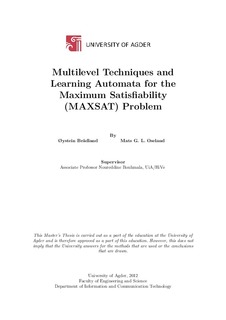| dc.contributor.author | Brådland, Øystein | |
| dc.contributor.author | Oseland, Mats G.L. | |
| dc.date.accessioned | 2012-10-03T11:09:45Z | |
| dc.date.available | 2012-10-03T11:09:45Z | |
| dc.date.issued | 2012 | |
| dc.identifier.uri | http://hdl.handle.net/11250/137551 | |
| dc.description | Masteroppgave i informasjons- og kommunikasjonsteknologi IKT590 2012 – Universitetet i Agder, Grimstad | no_NO |
| dc.description.abstract | The Maximum Satisfiability (MAXSAT) Problem is a propositional logic and an optimization
based problem that has great importance in the theoretical and practical domain. In
the recent years MAXSAT has risen great interest in the industry. Example problems from
the industry that can be encoded as MAXSAT problems are circuit design and debugging,
hardware verification, bioinformatics and scheduling. These kind of problems often tend
to be large and increase exponentially with the problem size, and therefore algorithms for
solving such problems incorporate different techniques and methods to solve the problems
in a smart and efficient manner.
In this thesis we introduce a range of algorithms that extend the well-known Stochastic
Local Search (SLS) algorithm called WalkSAT. WalkSAT is extended with the multilevel
paradigm and Learning Automata. The multilevel paradigm is a technique that splits large
and difficult problems into smaller problems. These problems are expectedly less complex
and therefore easier to solve. Learning Automata are a branch of machine learning that
can be seen as a decision-making entity that is employed in an unknown environment.
Through feedback from the environment the Learning Automata try to learn the optimal
actions.
The core of this thesis is the observations and findings of how these dissimilar techniques affect
the performance and behaviour of WalkSAT when solving industrial MAXSAT problem
instances. Through extensive experiments our results confirm that combining multilevel
techniques and Learning Automata with WalkSAT, separately and together, give promising
results. We compare these composite algorithms with WalkSAT on selected industrial
MAXSAT problems throughout the thesis, and show that all these composite algorithms
perform better than WalkSAT. | no_NO |
| dc.language.iso | eng | no_NO |
| dc.publisher | Universitetet i Agder / University of Agder | no_NO |
| dc.title | Multilevel techniques and learning automata for the Maximum Satisfiability (MAXSAT) problem | no_NO |
| dc.type | Master thesis | no_NO |
| dc.source.pagenumber | XI, 66 | no_NO |
